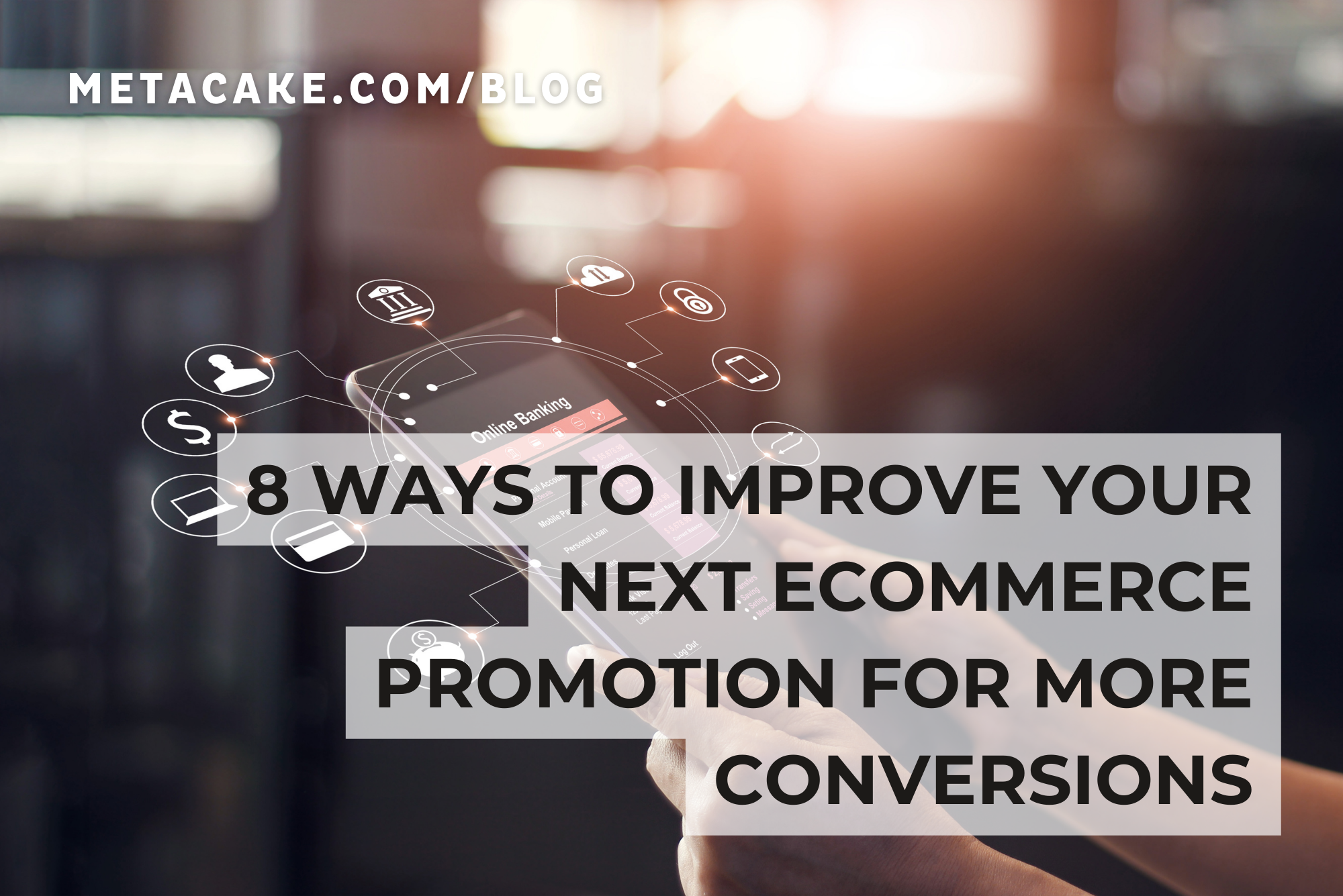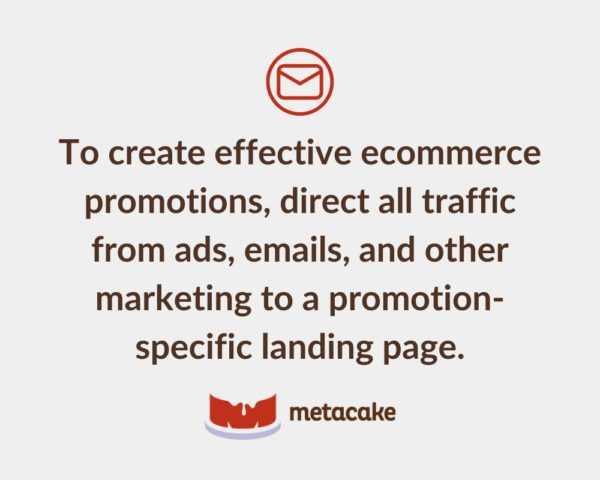
8 WAYS TO IMPROVE YOUR NEXT ECOMMERCE PROMOTION FOR MORE CONVERSIONS
For most ecommerce brands, promotions and sales are the business’s lifeblood.
Whether it’s an annual Black Friday / Cyber Monday sale, an Independence Day promo, or just a weekend flash sale, ecommerce promotions boost revenue, draw new traffic, and propel your brand onward.
What Are Ecommerce Promotions?
Ecommerce promotions are events brands run on their ecommerce websites to generate customer interest and attract new visitors.
Brands commonly build their promotions around product discounts, new product launches, and contests or giveaways. They then market the promotion through organic and paid channels to spread the word and drive traffic.
Why Ecommerce Promotions Matter
Retail (in-store and online) has revolved around promotions for years, most notably during Q4 and other major holidays. While brands need evergreen marketing running year-round to maintain top-of-funnel traffic, regular ecommerce promotions are crucial for stoking momentum.
A healthy calendar of ecommerce promotions is a great way to boost revenue and hit annual targets. It also helps brands acquire new customers and cultivate fans.
The best way to plan ecommerce promotions is with an integrated marketing planner.
When Do Ecommerce Promotions Fall Short?
Planning is one of the most important yet overlooked components of successful ecommerce promotions.
With the fast pace of life and business, brands often fall into a last-minute-promo mentality, abruptly realizing the need for a sale because Father’s Day is next weekend or they need a bump in revenue.
Unfortunately, a lack of planning often means frazzled staff, little time for effective marketing, and overlooked details — like how to convert customers without a great deal. It takes more than a 30% off ad on Facebook to get customers to purchase.
So, to have successful ecommerce promotions, what do you need besides a great offer? Below, we explore eight ways to increase the effectiveness of every promotion you run.
8 Steps to Convert More Customers With Your Ecommerce Promotions
Instead of focusing only on what deal to offer (A flat discount? BOGO? Gift with purchase?), consider the entire customer journey. Follow these eight steps to build a strategic, well-rounded, successful ecommerce promotion:
1. Start With Your Audience
Always start by looking at the customer.
Understand who they are and what they need, then create a sale that addresses those needs. This will inform your site’s messaging and even the discount you offer.
For example, if your customers love a great deal, try offering a flat percentage discount. However, if your customers don’t care about the price but value quantity, a BOGO or bonus gift might excite them more.
If you haven’t already, get to know your customers using an ecommerce customer avatar template. This exercise will help you and your team learn who your customers are beyond demographic information, which will help you create better experiences for them.
As you explore each avatar’s personality, interests, values, needs, and concerns, use our free template to guide your thinking.
2. Sell Your Brand, Not Your Product
Creating lifelong brand evangelists is the key to long-term success. If customers buy into your product but not your brand, you close the sale but don’t win the customer.
That customer can buy a product similar to yours anywhere else. So, if you want them to return, they need to buy into your brand.
Take every opportunity to sell your brand, promotions included. Ensure your website experience implicitly builds your brand through your messaging, imagery, warranty or guarantee, customer service, and more.
Look at your homepage’s hero image, your ad copy, your email design, etc., and ask yourself, “Does this communicate what our brand is? If we removed our logo, would people still know it’s us?”
3. Simplify
Clarity increases conversions because confused people don’t buy.
Message your sales clearly and concisely. Make it obvious why you’re running the sale, what the offer is, and how to get the discount. Use clear messaging and CTA buttons to lead your customers on the right path rather than make them wander around your site. This path is called the ecommerce customer journey.
Make your warranty, customer guarantee, and customer reviews very clear. Putting these trust-building elements in the customer’s line of vision reduces barriers to purchase.
You’ll also want to limit the customer’s choices to avoid distracting them on their way to checkout. If you have custom products, offer pre-designed customizations.
4. Be Prepared to Send Traffic to Your Site
In ecommerce, you have to send traffic to your site, and often, you have to pay for it.
This could be through paid advertising on Facebook, Instagram, Google, or YouTube. You could also use SEO or email marketing, or work with influencers and affiliates.
Whatever your brand uses, you’ll need to plan your promotions around a budget. Figure out how much you can spend capturing users and getting them to your site.
5. Work Smart With Technology
Years ago, ecommerce owners had to build their sites from scratch, and they needed a team of IT people to stay up all night to make sure sales went live without hiccups.
Thanks to apps that make life easier, that’s no longer the case.
Technology like Shopify Plus has simplified the actual launch of sales. This allows you to focus your team’s effort on creating great products and content and connecting with your customers.
For a successful promotion, use these apps, and don’t reinvent the wheel. As you use technology to work smarter and not harder, make sure everything you do is just as optimized for mobile, and make sure your site is as fast as it can be, removing any unneeded apps.
Finally, test everything before it goes live.
6. Acquire More Than Just Purchases
Purchases are the goal, but most site visitors won’t convert.
A great conversion rate for a site with a lot of traffic is 4–6%. That means, at best, 94% of your visitors won’t buy from you. Don’t base your marketing goals on your conversion rate — it’s difficult to improve that systematically.
Instead, create a “conversion funnel” that aligns with your ecommerce customer journey. This is simply a list of the micro-conversions along the path to the purchase (gathering email signups, pushing people to a product page, getting people to add to cart, etc.).
When you track the smaller conversions that lead to a purchase, you’ll understand what needs to improve to increase purchases. You’ll also be able to create initiatives or campaigns that encourage lower-friction conversions, such as email sign-ups.
7. Measure the Right Metrics
If you’re tracking activity on your site, you need to know which metrics to measure. With Google Analytics at our disposal, it’s easy to get so overwhelmed by data that you end up doing nothing with it.
The key is to determine what metrics matter to your business, especially during sale time, so that you can evaluate what made your sale successful.
Watch these metrics closely:
- Traffic: Monitor your site traffic levels, where it comes from, and the balance of new vs. returning visitors. Try to achieve a ratio of 60% new visitors to 40% returning.
- Time on Site: Watch the amount of time visitors spend on your site and on specific pages.
- Newsletter Subscribe Rate: Monitor this, especially if you use incentivized pop-ups.
- Add to Cart Rate: Track how many people add to cart versus simply viewing the product page.
- Abandoned Cart Rate: How many people leave before completing checkout?
- Conversion Rate: Compare your store’s conversion rate to the conversion rate during non-sale periods.
- Average Order Value (AOV): Your goal AOV should be greater than 1.5x your average product price.
- Customer Lifetime Value (CLV): Measure this at different intervals (30, 60, and 90 days) to identify your peaks and opportunities.
8. Always Use Landing Pages
To create effective ecommerce promotions, direct all traffic from ads, emails, and other marketing to a promotion-specific landing page.
Directing all your traffic to your homepage almost always leads to higher exit rates and lower conversions. That’s because your homepage isn’t meant to help convert site visitors. It’s meant to orient the visitor and quickly direct them where they need to go.
Pro tip: Create more than one landing page for your sale to cater to different audiences. The more personalized your messaging, the better your conversion rate.
Landing pages also make tracking your paid advertising in Google Analytics easier, especially for Facebook advertising. Because of new updates to user activity tracking, attribution is more complicated than ever. Think ahead with specific landing pages and UTMs.

Ready to Make Waves With Your Next Promotion?
Next time you run a sale, follow these eight steps. Thinking of your customers first and creating a clear and compelling experience won’t just improve sales. It’ll create brand evangelists and increase customer lifetime value, which is the secret to long-term ecommerce success.



